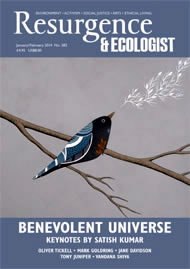“Cities built like oysterbeds, rainforest communities singing with tree frogs. A leading designer insists that beauty is inherent in sustainability. His seductive argument: form and image can powerfully enhance conservation, comfort and community at every scale of design, from products and buildings to entire cities.”
I pleaded, I begged. Look, I protested, my endorsement above is on the book’s back cover – encouraging people to read it and using words like beautiful, sensual, sexy. So I’m compromised and shouldn’t be writing a review. No, I was instructed, this one’s for you. That said, I’m now thrilled that Satish insisted, because I had to reread The Shape of Green, and it was even better than I remembered.
This is a passionate book. Early on, Lance Hosey takes a vigorous swipe at Nissan, specifically its all-electric car, the Leaf. He quotes a design critic to the effect that the Leaf “is as dull in style as most gas-guzzlers”. Nor is this unusual, sadly. Most people building sustainability-focused products obsess with energy efficiency, carbon emissions or material chemistry, Hosey observes: “issues that belong in a technical manual, not on a napkin sketch”.
Then he hammers the nail home: “Nuts and bolts are not exactly the stuff of every designer’s dreams,” he says. “As a result, many consider great design and green design to be separate pursuits, and in fact much of what is touted as ‘green’ is not easy on the eyes. The ugly truth about sustainable design is that much of it is so ugly.” Whereas environmentalists think that if a design is not sustainable it can’t be beautiful, a view Hosey shares, he also wants to turn it around.
Meanwhile, much of what we find to be beautiful has evolved over time, interacting with the environment. At one point we are asked to consider the question: “What is the sound of sustainability?” Hosey recalls that Gregorian chant evolved in response to the long reverberation time of the previous version of St Peter’s Basilica in Rome. As he recalls, the “priests and chanters learned to dwell on a particular pitch, around A or A flat, the building’s ‘sympathetic note,’ its acoustical sweet spot”. He also spotlights the Kaluli people of Papua New Guinea, whose songs echo nearby birds, insects, tree frogs, waterfalls and rain. The music, as one anthropologist put it, uses the wider landscape as a tuning fork.
So a key question is how architecture and design can interact – even play – more creatively with our wider environment. One solution proposed for New York harbour involves the creation of “soft infrastructure”, an array of boomerang-shaped barrier islands that slow and diffuse storm surges of the sort generated by Superstorm Sandy. Nor is this just passive resistance: the islands also accumulate sediment over time, growing naturally into wetlands, wildlife habitats and community parks. Design working with, rather than against, the grain of Nature.
Intriguingly, Hosey talks of the natural selection of cities, delving into the principles of urban ecology and the future of urban agriculture. Many of tomorrow’s cities may well evolve out of today’s slums, with the book arguing that favelas are starter cities, early shoots of a new style of urbanism.
Environmental intelligence demands aesthetic understanding. Hosey notes that the Apollo photographs of Earth showed “how profoundly image can inspire ethics. Likewise, aesthetics can promote action. Imagery inspired the environmental movement, and created great imagery”.
He ends with a 10-point ‘Beauty Manifesto’, the second point being that we must “Turn beauty and sustainability into the same thing”. Ultimately, this isn’t about luxury or superficiality: it’s about solutions that resonate with all life.







